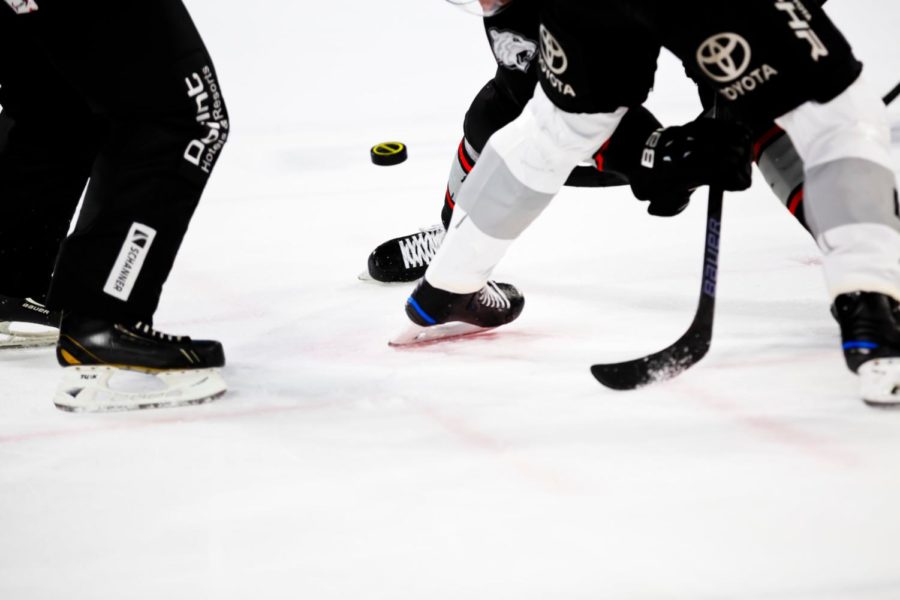NCAA Frozen Four: A chilling road to the finish
Used with permission by Markus Spiske on Unsplash
A minute to win it. The UMass Minutemen rush out on the ice to celebrate their hard-fought victory. They won their first title in program history.
May 20, 2021
The Frozen Four came and the Frozen Four went, and now it is time to recap the event and highlight some of its memorable moments. For those who are unfamiliar with the Frozen Four—no, it is not Disney’s upcoming fourth movie in the Frozen series. Rather, it is a men’s ice hockey tournament sanctioned by the National Collegiate Athletic Association (NCAA). More specifically, the Frozen Four refers only to the semifinals while the entire tournament consists of four rounds.
This year, it was held at PPG Paints Arena, home of the NHL’s Pittsburgh Penguins, in downtown Pittsburgh, Pennsylvania. For reference, the Frozen Four has been held in venues that house other NHL teams like Tampa Bay Lightning’s Amalie Arena, Chicago Blackhawks’ United Center, and Minnesota Wild’s Xcel Energy Center, just to name a few. Unlike in previous years, this year’s tournament did not have as many fans. Although there were people in the stands, their chants and cheers were nowhere close to the thunderous applause and raucous clamor of previous tournaments. While this was the case, the lack of fans at the games did not undermine the weight these games carried.
This year’s four teams consisted of the University of Minnesota Duluth, St. Cloud State University, Minnesota State University, and the University of Massachusetts. These four teams would duke it out to decide who the best team in the nation would be.
Four hungry teams. One shiny trophy. Who would win this year’s national championship?
To begin, the University of Minnesota Duluth (UMD) Bulldogs, having won the past two Frozen Fours, looked to win their third consecutive title this year. A handful of teams in Frozen Four history have won back-to-back titles, but only the Michigan Wolverines have pulled off the three-peat (1951-53). UMD was trying to accomplish a feat that had not been done in over 50 years. The stakes were high for the Bulldogs, but they were on a mission, and they would not go down without putting up a fight.
The start of their tournament was a bit bizarre, to say the least. They advanced to the second round without having to play a minute of hockey. The reason? Their first-round opponent, the University of Michigan, was not in compliance with the COVID-19 protocols, thus declaring their match against the Bulldogs a no-contest. It was very unfortunate for the Wolverines, who were poised to make a dominant run for the title, but Minnesota Duluth received a free pass to the second round nevertheless. The Bulldogs’ second-round opponent was the University of North Dakota Fighting Hawks, whom had beaten American International College by a score of 5-1 in the first round. The Bulldogs, who were slight favorites to win the game, squeezed out a win against North Dakota, 3-2, after what was the longest hockey game in NCAA tournament history. In its fifth overtime period, UMD’s Luke Mylymok, a freshman, scored the game-winning goal to send the Bulldogs to their third straight Frozen Four appearance.
MOVIN ON BABY!! @UMDMensHockey tops North Dakota, 3-2, in five overtimes. Mylymok nets the game-winner. Bulldogs are Frozen Four bound.#BulldogCountry pic.twitter.com/TOGx54f7pm
— UMD Athletics (@UMDBulldogs) March 28, 2021
Up next, the Minnesota State Mavericks. An unlikely contender for this year’s championship, the Mavericks found a way to the semifinals. They edged out Quinnipiac University, 4-3, and upset their in-state rival, the University of Minnesota, in a 4-0 shutout. This marked their first Frozen Four appearance in school history, which could be deeply attributed to their starting goaltender, Dryden McKay, who, in his three-year college career, had amassed 75 victories and looked to add to that total in the semifinals. Donned in purple and gold, they had something to prove and looked to win their first championship.
St. Cloud State’s path to the Frozen Four presented wins against Boston University and Boston College by scores of 6-2 and 4-1, respectively, both of which were decisive victories. The Huskies were back in the Frozen Four for the first time since 2013. However, this 2021 team was without its best goal scorer, Easton Brodzinski, after he sustained a season-ending injury in the East Regional. Barring any further injuries to their roster, the Huskies remained in contention for the national title, and like the Mavericks, sought to win their first championship.
The University of Massachusetts (UMass) Minutemen crushed Lake Superior State 5-1 and did the same to Bemidji State by a score of 4-0. Some have claimed the Minutemen’s path to the Frozen Four was easy due to their weak competition and that they were lucky because they didn’t have to face the University of Wisconsin, the highest-ranked team in the region, and the arguably tougher opponent. However, the Minutemen performed as they should have, so their quote-unquote easy path to the semifinals should not have undercut their competitiveness and ability to win hockey games.
The Minutemen sought vengeance against Minnesota Duluth, whom they lost to in the 2019 title game. But this year, the two squared off in the semifinal game. Unfortunately for the Minutemen, they were without starting goaltender Filip Lindberg and leading goal scorer Carson Gicewicz due to COVID-19 protocols. Others ruled out for the same reason were forward Jerry Harding and backup goaltender Henry Graham. With their roster depleted, it seemed they were doomed to suffer a mighty loss at the hands of Minnesota Duluth. The Minutemen, however, sought to stifle their opponents and claim their first title.
Even with a couple of first-round games being canceled due to teams having players and/or coaches test positive for COVID-19, the rest of the games transpired, and four teams qualified for the semifinals usual. These teams had a lot riding on the games, and they wanted to win for various reasons. For some, it was to make history. For others, it was to obtain glory. In any case, someone would be crowned as national champions.
The first game on the April 8th slate featured the St. Cloud State Huskies against the Minnesota State Mavericks. The second game saw the Minnesota Duluth Bulldogs take on the UMass Minutemen. Both semifinal games were back-and-forth battles packed with excitement that were ultimately decided by one goal.
The clash between St. Cloud State and Minnesota State was a high-scoring affair. The Huskies started the scoring with a goal during the fourth minute of the first period, after the Mavericks took a penalty after 2:12 of the first period. The next goal came from the Mavericks later in the first period, following a Huskies’ penalty. The Huskies immediately answered back with a goal of their own only ten seconds after the Mavericks scored. By the end of 20 minutes, it was evident the game was going to come down to the wire.
The second period featured more scoring, with the Huskies striking first following two minutes into the period. The Mavericks clapped back with two consecutive goals to tie up the score, three all.
The third period displayed two weary teams that still had their minds set on the championship. Both teams were running out of steam but were still hungry for the taste of victory. The Mavericks broke the tie after scoring an even-strength goal within the four-minute mark; they were up 4-3 and looked to close the door on the Huskies. All they had to do was defend their net and prevent any pucks from going in, whatever it took. Unfortunately for them, it was easier said than done. Not only did they relinquish their 4-3 lead, but they also did not score for the remainder of the period. They went on to lose 5-4.
Similarly, the game between UMass and Minnesota Duluth was a nail-biter. In the opening period, both teams tacked on their own goal, with the Minutemen scoring in the fifteenth minute and the Bulldogs scoring shortly after. In contrast, the second period saw the Bulldogs take the lead by scoring a goal in the eleventh minute, with Cole Koepke whisking the puck past the UMass goalie and into the back of the net after his first shot on net was blocked. Later in the period, the Minutemen had a great scoring chance after intercepting an errant Bulldog pass, but UMD’s netminder made a spectacular leg save to prevent the puck from entering the net.
After two periods, the Bulldogs were on top two goals to the Minutemen’s one. Heading into the final period, UMD was on the verge of its third consecutive championship appearance while UMass wished to avoid enduring another doomed fate against the Bulldogs. With twenty minutes left to play, the Minutemen were on the clock. All they needed to do was score at least one goal to send the game into an overtime period where they would hope to win it then. The odds were stacked against them, though, and UMD looked poised to shut them down with their defensive schemes and their brick wall of a goaltender in Zach Stejskal. Would they pull it off? Or would they once again become fall prey to the UMD Bulldogs? There was only one way to find out.
At the sound of the referee’s whistle, the skaters lined up at the faceoff circle. Once the referee threw the puck down on the ice, the third period was underway. While the Bulldogs retained control of the puck, the Minutemen were quick to steal the puck away, adopting an aggressive style of play and applying constant pressure in the offensive zone. Finally, during a scrummage at the front of UMD’s net, Anthony Del Gaizo of UMass sent a rebounded puck into the back of the net with a quick snap of his stick. Just like that, the Minutemen tied the game up at two goals apiece, and the momentum changed hands. Although there were no goals for the remainder of the period, the Minutemen made it extremely difficult for the Bulldogs to create scoring opportunities with their speed and intensity.
Overtime was a tale of two teams. On one hand, UMass continued to ride the wave of momentum it attained during the third period. On the other hand, UMD was dead on its feet and did not at all look like the formidable team it was at the beginning of the contest. The Minutemen’s high energy and hostile play coupled with the Bulldogs’ lack of urgency and spirit contributed to the Bulldogs’ ultimate demise. The Minutemen maintained possession of the puck in the offensive zone for the majority of the period, they defended against UMD’s efforts, and they applied constant pressure on UMD’s goalie. They sent a barrage of shots at the net to try to score one more goal, and after many shots, the puck eventually found the inside of the net, past the right leg pad of UMD’s goalie.
Garrett Wait gets the winner in OT to send UMass to the title game for the second straight Frozen Four.
What a story. pic.twitter.com/oZBAdpHHJ7
— Evan Marinofsky (@emarinofsky) April 9, 2021
The stage was set for the national championship. The UMass Minutemen versus the St. Cloud State Huskies. The Minutemen were coming back from a defeat in last year’s final and sought to win once and for all. Meanwhile, the Huskies had never been in the championship, but they too sought to win it all for the first time in school history. Who would make history?
Players from both teams lined up in the proper positions on the ice in preparation for the puck drop. Aaron Bohlinger of UMass scored at the seven-minute mark to give the Minutemen an early lead. St. Cloud State was unable to respond with a goal of their own, and their defense gave up another late goal in the first period. By the end of twenty minutes, the Minutemen led by two goals. The Huskies looked to answer back. But to no avail. Instead, UMass continued to apply the pressure onto St. Cloud’s goalie and scored their third goal of the game.
⚠️ ICYMI ⚠️@UMassHockey‘s Philip Lagunov turned it up a notch with this one🥵🔥#SCTop10 #NationalChampionship x 🎥 @espn pic.twitter.com/AOJs4p19Kr
— NCAA Ice Hockey (@NCAAIceHockey) April 11, 2021
Things continued to go downhill for the Huskies following that goal. The Minutemen scored again later in the second to go up 4-0 by the end of the second period. By the final period, the Huskies looked to make a final push to try to threaten the Minutemen’s lead but were unable to score even one goal. The Minutemen tacked on one more to win 5-0 and be crowned as the kings of college hockey.
A SHUTOUT ON THE BIGGEST STAGE AND THE MINUTEMEN ARE NATIONAL CHAMPIONS!🚩
For the first time in program history, @UMassHockey wins the #NationalChampionship with a dominant 5-0 win against St. Cloud State in the Steel City.#FrozenFour pic.twitter.com/JWm9lLiYZt
— NCAA Ice Hockey (@NCAAIceHockey) April 11, 2021
For UMass, they won their first championship in history and etched their names into the history books of NCAA Frozen Four winners.
It was a colossal failure on the behalf of St. Cloud State, one filled with horrid passing and costly penalties that ultimately sealed their fate. It turns out that when you hand the other team scoring chance after scoring chance, they will take advantage of the ineptitude. It was an overall mediocre showing from the Huskies, who had played great hockey leading up to the championship but did not bring out their A-game when it mattered most. It was a performance they wish they could take back, and it will leave a bad taste in their mouth in what could have been their triumph.
While it was tremendous to even have a Frozen Four this year amid the COVID-19 pandemic, the tournament could have been so much more had there been more fans in the building. Hopefully, by next year, the NCAA will be able to conduct the 2022 Frozen Four in a jam-packed arena with passionate and belligerent fans. Until then, the hockey world shifts its focus back onto the NHL and following the regular season, towards the 2021 Stanley Cup Playoffs this May.





